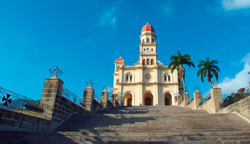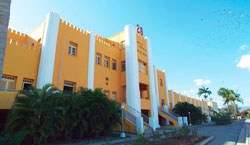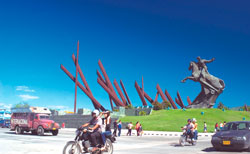
Two major historical events took place on July 25th that turned that date into a very important one for Santiago de Cuba: its foundation in 1515 and the eve of the assault on the Moncada barracks.
For this reason, every year on July 25th, in addition to the yearly celebration of the cityás anniversary, the day that Fidel Castro and his followers attacked the Moncada barracks to try and overturn the critical situation in the country is also commemorated.
 After the triumph of the Revolution in 1959, July 26 was named the 26th of July Movement" and even after 61 years the city continues to pay homage to this exploit, remembering those who lost their lives.
After the triumph of the Revolution in 1959, July 26 was named the 26th of July Movement" and even after 61 years the city continues to pay homage to this exploit, remembering those who lost their lives.
As we get closer to the metropolisá half millenium, the Santiagueros (natives of the city) will have the privilege of celebrating the cityás anniversary while being hosts to the main celebration of the Moncada attackás 62 years.
This was an initiative introduced by President Raúl Castro to the villagers last July 23rd from the Municipal Town Hall in whose balconies the victory of the Revolution was proclaimed on January 1st, 1959. Santiagueros enthusiastically accepted the idea.
Cradle of the Revolution
No other Cuban city is comparable to Santiago de Cuba. While many others boast and identify themselves with abundant parks and bridges, the stamp of a river or the beauty of its sea, this city prides itself on carrying its countryás name as part of its own. Heroine of the Republic since January, 1984, it has been named the Cradle of the Revolution.
 Among the challenges that touch Santiago is a peculiar topography marked by irregularities and three natural spaces that make the city into a lookout, along with the particular idiosyncrasies of its people: happy, extroverted and rebellious.
Among the challenges that touch Santiago is a peculiar topography marked by irregularities and three natural spaces that make the city into a lookout, along with the particular idiosyncrasies of its people: happy, extroverted and rebellious.
As stated by Dr. Olga Portuondo, the cityás Historian, During the first half of the 15th century, the history of Santiago de Cuba was that of the whole Island". From its port and wellsheltered bay expeditions, explorers left for the conquest of new territories and commerce was activated with neighboring areas.
The town was forged by an ancestral legacy marked by European and African influence, as well as the mark of those who fled towards its coasts pushed by the Haitian Revolution at the end of the 18th century.
Today an intense bustle marks the historical center, with work being done in emblematic places such as the Metropolitan Cathedral, an ancient house where it is presumed Velázquez lived, the Emilio Bacardí Museum and the Museum of Decorative Arts. Within this urban plot stands out the remodeling of the Imperial Hotel, which will become a symbol of tourism for the city. Santiago de Cuba wants to promote its heriditary and cultural values, among which stand out its unique attributes as the cradle of son, trova and bolero.
 The city is home to more that 20 national monuments, among them the Saint Efigenia cemetery where lies the grave of the National Hero José Martí, a sacred altar for Cubans.
The city is home to more that 20 national monuments, among them the Saint Efigenia cemetery where lies the grave of the National Hero José Martí, a sacred altar for Cubans.
The Fort of San Pedro de la Roca del Morro, the archaeological site of the French coffee plantations and the French grave áLa Caridad de Orienté all keep the Haitian influence alive. They are Cultural Heritage of Humanity and summarize what has happened here in the past five centuries, as described in the poetic definition of ácuna y paná (cradle and bread) by the Cuban troubadour Pedro Luis Ferrer.